
by Moe | Jan 31, 2024 | Meaning of Symbols, Meaning of Words, Philosophy
Since ancient times, many philosophers, mathematicians, and theologians have said that the monad or number one represents a secret principle of a sacred central fire that unites all things forming our realities.
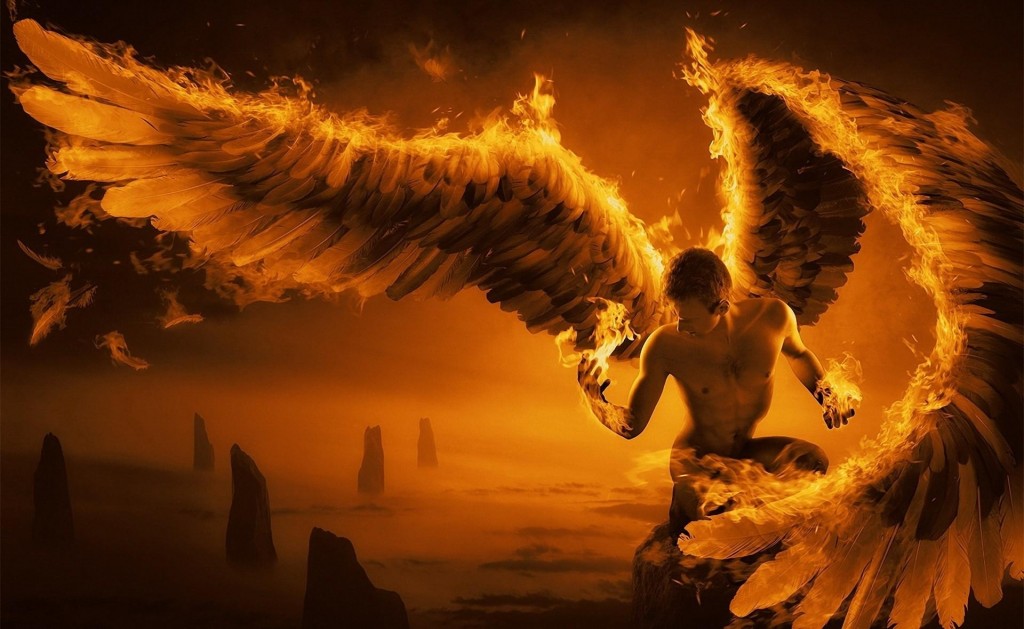
This concept has a profound significance in both philosophy and cosmogony for well over 2,000 years.
The Greeks called it the “monad or monas,” meaning “unity” or “oneness,” which represents the fundamental building block of existence. It was associated with the belief in the “prime mover” or the first cause that set the universe in motion.
This concept can be traced back to the teachings of ancient philosophers such as Pythagoras and Plato, who believed in the existence of a fundamental substance that underlies the diversity of the material world.
According to Pythagoras, who some consider the Father of Math and his followers, the Pythagoreans, the monad is the ultimate source of all existence.
In this philosophy, the number one or monad is considered the origin of numbers, as numbers are seen as the building blocks of reality. It stood at the pinnacle of this numerical hierarchy.
For the Pythagoreans, the Monad represented the source from which all other numbers and mathematical relationships were derived.
It symbolized unity, indivisibility, and the essence of all beings.
ORDO AB CHAO
The monad is seen as the creative force, fire or energenetic force that brings order out of chaos, giving rise to the intricate web of interconnectedness that defines our reality. It is the principle that brings about the principles of symmetry, proportion, and harmony that permeate the natural world.
In Pythagorean cosmogony, it serves as the guiding force that organizes or more appropriately, magnetizes the chaotic elements of the universe into a harmonious order. According to their teachings, each number possessed its own unique essence and vibrational frequency, and these vibrations were considered to be the very fabric of reality.
They believed that it gave rise to the dyad, which then generated all other numbers and the material world. It is the indivisible and immutable essence that underlies the entire cosmos.
This embodies the idea that everything in the universe can be reduced to a singular, fundamental unit. In its essence, it is the ultimate unity, the indivisible entity from which all things originate. Hence, the monad represents the primary building block of reality, the seed of creation, and the spark that ignites the cosmic order.
For Plato, this force or fire was called ether and was the substance by which the Craftsmam had created the universe and world. The Freemasons represent this with their motto, ORDO AB CHAO and the concept of the Great Architect of the Universe (T.G.A.O.T.U.).
This concept of the monad is often depicted as a circle, symbolizing its perfect and infinite nature.

THE MONAD IN ESOTERIC PHILOSOPHY
In the realm of ancient and esoteric philosophies, the concept of the Monad holds a significant place in Gnosticism, Hermeticism and Alchemy. These mystical traditions, intertwined with deep spiritual wisdom, have long sought to understand the nature of existence and the interconnectedness of all things.
In Gnosticism, the monad is at the root of the pleroma, the infinite fount of matter and energy in the universe.
In Hermeticism, the Monad is seen as the ultimate source of all creation, the divine spark from which everything springs forth. It represents the timeless and indescribable essence that permeates all levels of reality. This concept aligns with the idea of the One in Neoplatonism, emphasizing the unity and oneness of the universe.
Alchemy, on the other hand, views the Monad as the primordial substance or the original matter from which the alchemical transmutation takes place. It is the raw material that undergoes various stages of refinement and purification, ultimately leading to the attainment of perfection or the Philosopher’s Stone.
It symbolizes the potential for transformation and the inherent unity of all elements.
33rd Degree Freemason and author, Manly P. Hall wrote;
“The number one was the point within the circle , and denoted the central fire , or God , because it is the beginning and ending ; the first and the last . It signified also love , concord , piety , and friendship , because it is so …”
Hall said, “The sun is a great dot, a monad of life, and each of its rays a line – its own active principle in manifestation.
The key thought is: The line is the motion of the dot. The dot, or Sacred Island, is the beginning of existence, whether that of a universe or a man.”
It is seen as the unity that precedes duality, representing the transition from the formless to the formed.

Just as the concept is a single entity, it is also considered the harmonious union of opposites. It represents the synthesis of opposites such as light and darkness, male and female, unity and multiplicity, and harmony, balance or order.
As Plato wrote, “Love is born into every human being; it calls back the halves of our original nature together; it tries to make one out of two and heal the wound of human nature.” (Plato, The Symposium)
From Plato, Neoplatonism, placed great emphasis on the concept of the Monad, particularly through the teachings of one of its prominent figures, Plotinus.
According to Plotinus, the One is beyond all categories and distinctions. It is ineffable and transcendent, beyond the grasp of human comprehension. It is the origin and cause of all things, the pure essence from which everything else derives its being.
Plotinus taught that through contemplation and philosophical inquiry, individuals can come to realize their connection to the One and experience a sense of oneness with the ultimate reality.
In Neoplatonic philosophy, the journey towards understanding the One, or the Monad, is seen as a spiritual ascent. This journey involves transcending the limitations of the material world and ascending through the various levels of existence, ultimately reaching a state of unity with the One.
This realization brings about a transformative spiritual awakening, leading to a higher understanding of the self and the universe.
THE MONAD IN EASTERN PHILOSOPHY
In Chinese philosophy, the concept of the monad is reflected in the teachings of Taoism, where it represents the ultimate source of all things. Taoism, rooted in the profound wisdom of Lao Tzu’s Tao Te Ching, delves into the fundamental principles of existence and the interconnectedness of all things.
At the heart of Taoist philosophy lies the concept of the Tao, often described as the “Way” or the “Ultimate Reality.”
It is the underlying force that governs the universe, encompassing both the seen and unseen aspects of existence representing the unifying essence that flows through all things, connecting them in a harmonious and ever-evolving dance.
According to Taoist teachings, it is the eternal and unchanging essence that transcends the duality of existence, encompassing both yin and yang, darkness and light, movement and stillness.
The Taoist sages emphasize the importance of aligning oneself with the flow of the monad, harmonizing with its rhythms and embracing the natural order of the universe.
It was also explored in Indian philosophy, particularly in the school of Hindu philosophy known as Advaita Vedanta. Here, the monad, referred to as “Atman,” is considered the eternal, unchanging essence of the self, which is indistinguishable from the ultimate reality, known as “Brahman.”
This idea of the monad was incorporated within monotheism, and the monotheistic religions symbolized as God or the universe.
It served as a metaphorical representation of the divine spark present within every individual. The Monad was seen as the innermost essence of the human soul, connecting each individual to the universal cosmic order.
It embodied the idea that each person possessed a unique and irreplaceable role within the grand tapestry of existence.
Hence, One God. One Lord. One Faith and One Baptism by Holy Fire (monad) – Not water.
To reunite with the One of God was to be Born Again.
The Prodigal son who was lost is now found.
THE MONAD IN MODERN SCIENCE
In the field of science, the notion of a unified theory that explains the fundamental workings of the universe has been a longstanding pursuit.
From the Ancient Pythagoreans and Plato to Leibniz’s monadology and modern science and philosophy, the concept of the monad has provided the unifying framework for the theory of relativity to quantum mechanics, understanding consciousness, free will, and the nature of reality itself.
In the 17th century, German philosopher and mathematician Gottfried Wilhelm Leibniz revived the concept of the monad. His magnum opus, “Monadology,” provides profound insights into the nature of reality, metaphysics, and the interconnectedness of all things.
In “Monadology,” Leibniz presents a metaphysical framework that explains the nature of existence and how monads relate to one another. He argues that they do not directly interact but rather harmoniously coexist in a pre-established harmony, orchestrated by a divine entity.
Leibniz’s modern concept of monadology challenges the traditional understanding of causality and suggests a synchronized universe where every monad’s actions align with the actions of other monads, creating a grand cosmic dance.
Influenced by his studies in mathematics and metaphysics, Leibniz proposed that monads were the basic units of reality, each possessing its own unique properties and experiences. He said they were indivisible and could not be influenced by external forces, but rather, they interacted with one another through a pre-established harmony.
According to Leibniz, they are indivisible, immaterial substances that are the fundamental building blocks of the universe.
Each is unique, representing a distinct perspective on reality.
These monads are not passive entities but rather possess inherent qualities and capacities that allow them to perceive, act, and interact with other monads.
He suggests that each one possesses a unique perception of the universe, which he calls “apperception.”
This individualistic perspective shapes the experiences and consciousness of each monad, making them active participants in the construction of reality. Hence, each individual substance is seen as a unique monad with its own perception and consciousness that are co-creators or builders of the world in which we live.
Epistemologically, Leibniz’s monads provide a unique perspective on the nature of knowledge or Gnosis.
Since each monad is a separate and distinct microcosm of the universe, it possesses its own unique perspective and experiences. This notion of “pre-established harmony” suggests that each monad has access to a specific set of truths, forming the basis of its individual knowledge.
Hence, no two humans are exactly the same.
Furthermore, Leibniz proposes that they are not confined to the physical realm but also exist in the realm of immaterial substances. This duality allows for a deeper exploration of the connection between mind and matter, challenging the Cartesian mind-body dualism prevalent during his time.
In the realm of physics, the concept of the Monad resonates with the fundamental building blocks of the universe. In particle physics, for instance, the notion of elementary particles can be seen as analogous to monads.
These indivisible units, such as quarks or electrons, possess unique properties and interact with one another to form the complexity we observe in the physical world.
In biology, the concept can be related to the idea of the cell as the fundamental unit of life. Just as monads are self-contained entities, cells possess their own internal structures and functions, while simultaneously interacting with other cells to compose the complex organisms we observe.
Moreover, the concept of the Monad has also sparked intriguing discussions in fields such as psychology and consciousness studies. Some theorists propose that the monad can be associated with the individual consciousness, representing a unique and self-contained center of experience within each person.
Additionally, the concept of monads has found resonance in cosmogony, the study of the origin and evolution of the universe. They are seen as the primordial entities that give rise to the diversity and complexity of the cosmos.
Monads represent the underlying fabric from which everything emerges and are seen as the driving force behind the dynamic unfolding of the universe.
In the realm of mathematics and computer science, the concept of the Monad has found its home in the paradigm of functional programming. Functional programming is an approach to software development that emphasizes the use of pure functions and immutable data.
In functional programming, a monad represents a computational context or a sequence of computations. In functional programming, it provides a clear separation between pure computations and impure actions, promoting code that is easier to reason about and test.
It allows developers to encapsulate side effects, such as reading from or writing to a database, handling exceptions, or dealing with I/O operations, within a controlled and composable structure. This enforces an explicit and disciplined mathematical approach to handling effects, ensuring that their impact is predictable and managed within the confines of the Monad.
At the core of the Monad in functional programming lies the bind operation, often represented by the symbol “>>=”, which allows sequential composition of computations within the Monad. This enables developers to chain together a series of operations, each dependent on the result of the previous one, without explicitly dealing with the underlying data transformations or side effects.
Hence, ALL IS MATH.
By leveraging the Monad, functional programmers can write code that is concise, modular, and reusable, which simplifies complex operations and promotes a declarative style of programming. It enables them to leverage the principles of functional programming to write elegant and efficient code, while also appreciating the historical and philosophical roots of this powerful concept.
Today we can see this in real time with social media platforms like X, Facebook and Instagram that are monotheistic hosts to billions of people, each living in their own multipolar worlds.
Worlds that are not defined by biological traits, genetics, and common characteristics, but by various degrees and categories of knowledge, ideas and wisdom or a lack thereof.
Let me remind you that in modern monadology, monads are individualistically magnetic and like attracts like.
This is why in the monotheistic religion of Christianity, the great teacher Jesus said;
“My people are destroyed for lack of knowledge: because thou hast rejected knowledge, I will also reject thee, that thou shalt be no priest to me: seeing thou hast forgotten the law of thy God, I will also forget thy children.” – Hosea 4:6
CONCLUSION
In conclusion, the significance of monads in modern philosophy lies in their role as fundamental entities that shape our understanding of existence, consciousness, and the interconnected nature of reality.
It invites us to question the nature of the world as we contemplate the interplay between unity and multiplicity, and delve into the depths of our own existence.
As we embark on this monadic journey, we open ourselves to new insights and perspectives that can enrich our understanding of the profound mysteries within the cosmic tapestry (filamental web) that surrounds us.

by Moe | Apr 22, 2023 | Neoliberalism, Philosophy, Traditionalism
The Dark Enlightenment is a loosely defined intellectual movement that emerged in the early 21st century. It seeks to challenge the assumptions of the liberal democratic tradition that emerged after the Enlightenment period.
While there is no single, unified Dark Enlightenment theory, its adherents share a broad set of concerns about the current state of society.
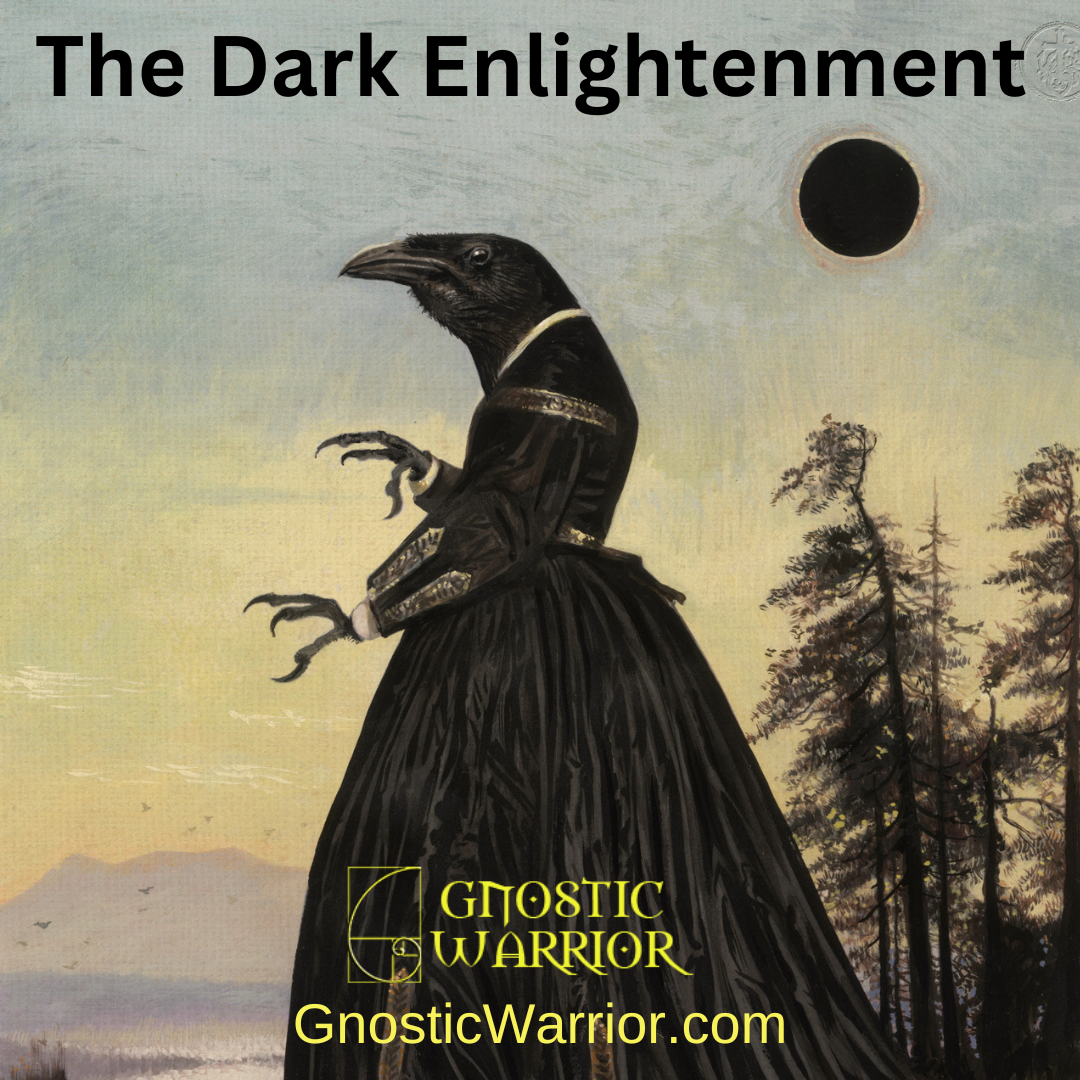
They seek to develop alternative models for governance, culture, and social organization.
Its core philosophy can be traced back to two prominent philosophers of the 19th and 20th centuries, Friedrich Nietzsche and Martin Heidegger. Both Nietzsche and Heidegger had critiqued the Enlightenment’s emphasis on rationality and the individual, but their philosophies were from different ideological perspectives.
Nietzsche was more of a liberal, individualist, progressive, and anti-traditionalist, while Heidegger advocated for Traditionalism but with more of a modernist approach.
Nietzsche argued that traditional values, particularly those propagated by organized religion and societal norms, hindered the individual’s development of their own unique potential, leading to conformity and suppression of individuality.
He saw traditionalism as a form of herd mentality that stifled creativity, vitality, and self-realization.
Nietzsche famously declared that “God is dead” and criticized traditional religious beliefs as outdated and detrimental to human flourishing.
On the other hand, Martin Heidegger, a prominent figure in existentialist and phenomenological philosophy, had emphasized the importance of tradition in shaping human existence and thought.
He saw tradition as an essential aspect of human existence, as it provided a sense of belonging, continuity, and rootedness.
He argued that tradition is understood as the shared history, language, and culture of a community, providing the framework for human existence and giving meaning to human life.
However, Heidegger also warned against the dangers of blindly adhering to tradition without critical reflection, as he believed that tradition could also become stagnant and prevent individuals from engaging authentically with their own existence.
He can be called a Progressive Traditionist who believed that respecting the autonomy of the individual to learn, grow and live in the modern world, rather than blindly following old traditions.
While both Nietzsche nor Heidegger never coined the term, the Dark Enlightenment, their ideas gained momentum in the 21st century as its core philosophers, with the rise of the internet and the proliferation of online communities.
One of the key figures in the modern development of the Dark Enlightenment in our day is Curtis Yarvin, who wrote under the pseudonym Mencius Moldbug.
Yarvin’s blog, “Unqualified Reservations,” became a hub for the movement, and he developed a following among tech elites in Silicon Valley.
His writings rejected democracy and called for a return to monarchy and aristocracy. He argued that democracy was inherently flawed because it placed power in the hands of the ignorant masses, who were susceptible to demagogues and populists.
Instead, he advocated for a system in which power was concentrated in the hands of a small elite, who were best equipped to make decisions for the good of society as a whole.
The movement is often associated with the alt-right, a far-right movement that emerged in the United States in the 2010s.
However, not all members consider themselves part of the alt-right, and the two movements have some differences in their ideologies.
At the heart of the Dark Enlightenment is a rejection of the liberal democratic tradition.
This is seen as having failed to provide a stable and sustainable governance model.
Adherents of the movement argue that democracy is inherently flawed because it places power in the hands of the ignorant masses, who are easily swayed by populist demagogues.
They argue that democracy leads to a “tyranny of the majority,” in which the interests of the minority are ignored in favor of the majority.
According to its core ethos, the liberal democratic tradition is characterized by a naive faith in progress, individualism, and equality.
These beliefs have resulted in social decay, cultural decline, and the erosion of Western civilization.
Instead, adherents of the Dark Enlightenment advocate for a system in which power is concentrated in the hands of a small elite, who are best equipped to make decisions for the good of society as a whole.
They also believe that this decay is the result of a number of factors. These factors include the breakdown of traditional values, the rise of secularism, the decline of religion, and the corruption of the political system.
They argue that this system would be more efficient and effective than democracy, as decisions would be made by those with the most knowledge and expertise.
To counteract these trends, Dark Enlightenment adherents advocate for a return to traditional forms of governance, cultural values, and social organization.
This includes a rejection of modern liberal democracy’s egalitarianism, which is considered unrealistic and undesirable.
Instead, the Dark Enlightenment promotes a hierarchy based on natural differences in ability and intelligence.
This hierarchy should guide decision-making in all areas of life, from politics to culture to personal relationships.
They argue that society is naturally hierarchical and that attempts to create a society based on equality are doomed to fail.
They believe that hierarchy is necessary for social order and stability, and that attempts to eliminate it will only lead to chaos and disorder.
It also emphasizes the importance of cultural and ethnic identities, which are seen as essential for maintaining social cohesion and a sense of purpose. This means that the movement is often associated with nationalism and ethnic chauvinism.
Some of its adherents have been accused of racism and xenophobia. However, many Dark Enlightenment thinkers reject these labels.
They argue that their ideas are based on a realistic assessment of the importance of cultural and ethnic identity in maintaining social order and stability.
Another key figure in the Dark Enlightenment is Nick Land, a former philosophy professor at the University of Warwick.
He began his career as a left-wing thinker and was associated with the “cybernetic culture research unit” at the University of Warwick, which explored the intersection of technology and culture.
Land has argued that democracy is a failed experiment that has led to the decay of Western civilization. It has also led to the rise of a parasitic class of elites who manipulate the masses for their own benefit.
He has said;
“The basic theme has been mind control, or thought-suppression, as demonstrated by the Media-Academic complex that dominates contemporary Western societies, and which Mencius Moldbug names the Cathedral.
When things are squashed they rarely disappear. Instead, they are displaced, fleeing into sheltering shadows, and sometimes turning into monsters.
Today, as the suppressive orthodoxy of the Cathedral comes unstrung, in various ways, and numerous senses, a time of monsters is approaching.”
Democracy is what prevents the realization of freedom, writes Land, suggesting that democracy is merely an Enlightenment myth:
“In European classical antiquity, democracy was recognized as a familiar phase of cyclical political development, fundamentally decadent in nature, and preliminary to a slide into tyranny,” Land says.
“Today this classical understanding is thoroughly lost, and replaced by a global democratic ideology, entirely lacking in critical self-reflection.
This ideology is asserted not as a credible social-scientific thesis, or even as a spontaneous popular aspiration, but rather as a religious creed, of a specific, historically identifiable kind,” Land had written.
His work is characterized by a rejection of traditional morality and a fascination with technology and artificial intelligence. Land believes that technological progress and social change should be accelerated rather than slowed down.
He argues that the only way to escape modern society’s constraints is to embrace the chaos of technological innovation and abandon the traditional values of liberalism and democracy.
Land says that humanity is rapidly approaching a point of technological singularity, at which point the distinction between humans and machines will become blurred.
In this new world, traditional morality will be replaced by a new form of ethics, based on the optimization of intelligence and the pursuit of power.
In addition to Moldbug and Land, there are a number of other thinkers associated with the Dark Enlightenment.
These include the man dubbed the world’s most dangerous philosopher, Alexandr Dugin, economist Tyler Cowen, the philosopher Peter Thiel, and the journalist John Derbyshire.
Dugin’s version of the Dark Enlightenment is heavily influenced by the ideas of Heidegger and the French thinker Julius Evola. He sees modernity as a crisis of meaning and identity, and argues that the only way to overcome this crisis is to return to Traditionalism.
He has argued that the Enlightenment project has been a failure. We need a new paradigm that is based on a rejection of individualism and an embrace of collective identity.
Despite the controversy surrounding his ideas, Dugin has become a prominent figure in Russian intellectual circles and has been influential in shaping political discourse in not only Russia, but also in the U.S. and around the globe. His philosophies have also gained traction among far-right and alt-right groups who see him as a kindred spirit in their quest to upend the liberal democratic order.
Peter Thiel, founder of PayPal and Palantir, and the first outside investor in Facebook, has been speaking about the Dark Enlightenment for years and on recent college tours discussing apocalyptic themes such as the Antichrist and the Apocalypse
Thiel’s views on the Dark Enlightenment and his association with its proponents have sparked controversy and criticism.
Some have accused him of promoting authoritarianism and fascism, while others have praised him for his willingness to challenge mainstream political and social norms.
In a 2009 essay for the Cato Institute, Thiel criticized democracy and argued that it had failed to deliver meaningful progress. He also expressed skepticism about the ability of individuals to make rational decisions and suggested that authoritarianism might be a better alternative.
In a 2013 interview with the National Review, Thiel expressed his admiration for Moldbug’s ideas and described him as “the most interesting thinker” in the tech industry. He has also been critical of Silicon Valley culture and has argued that it is too focused on individualism and not enough on the common good.
He suggested that the tech industry needs to be more willing to work with the government and embrace a more collaborative approach to solving problems.
However, the movement is characterized more by a shared set of concerns than by a unified intellectual program, and there is a great deal of debate and disagreement among its adherents.
Critics of the Dark Enlightenment argue that its ideas are fundamentally reactionary and represent a retreat from the advances of modernity.
They point out that the movement’s emphasis on hierarchy, tradition, and ethnic identity is reminiscent of the ideologies that gave rise to the most brutal atrocities in the past.

by Moe | Dec 26, 2022 | Neoliberalism, Philosophy, Political Metaphysics, Satanism, Traditionalism
“You offspring of snakes! How can you, being evil, speak good things? For out of the abundance of the heart the mouth (stoma | στόμα) speaks.” – Mathew 15:18
In Scripture, humans are described as having two distinctive minds. One center of power came from the “inner man or heart” and the other was the “outer man or flesh.”

Whichever “mind was in control” determined a person’s thoughts, actions, will and destiny which could either lead a person to their heavenly homeland or their own personal hells.
No one is immune from this law.
The inner man was always in battle or in contrast with the outer לבי ובשׂרי ירננו.
My heart and my flesh cry out Psalm 84:3; מעים Psalm 22:15; Jeremiah 4:19, the inner for outer מעים Jeremiah 49:22; as within the breast על לב Exodus 28:3,29,30
Within the heart is the mind and connection to God.
The heart represents the soul, mind, spirit, will, the whole inner man, that which makes him what he is, a conscious, intelligent, responsible being.
This is symbolized by the Catholic devotion called “The Most Sacred Heart of Jesus (Latin: Cor Jesu Sacratissimum)”, which is seen as a symbol of “God’s boundless and passionate love for mankind”.
In Christian iconography, this is often depicted with Jesus wearing “dual colored clothing” to represent this duality holding a flaming heart shining with divine light.
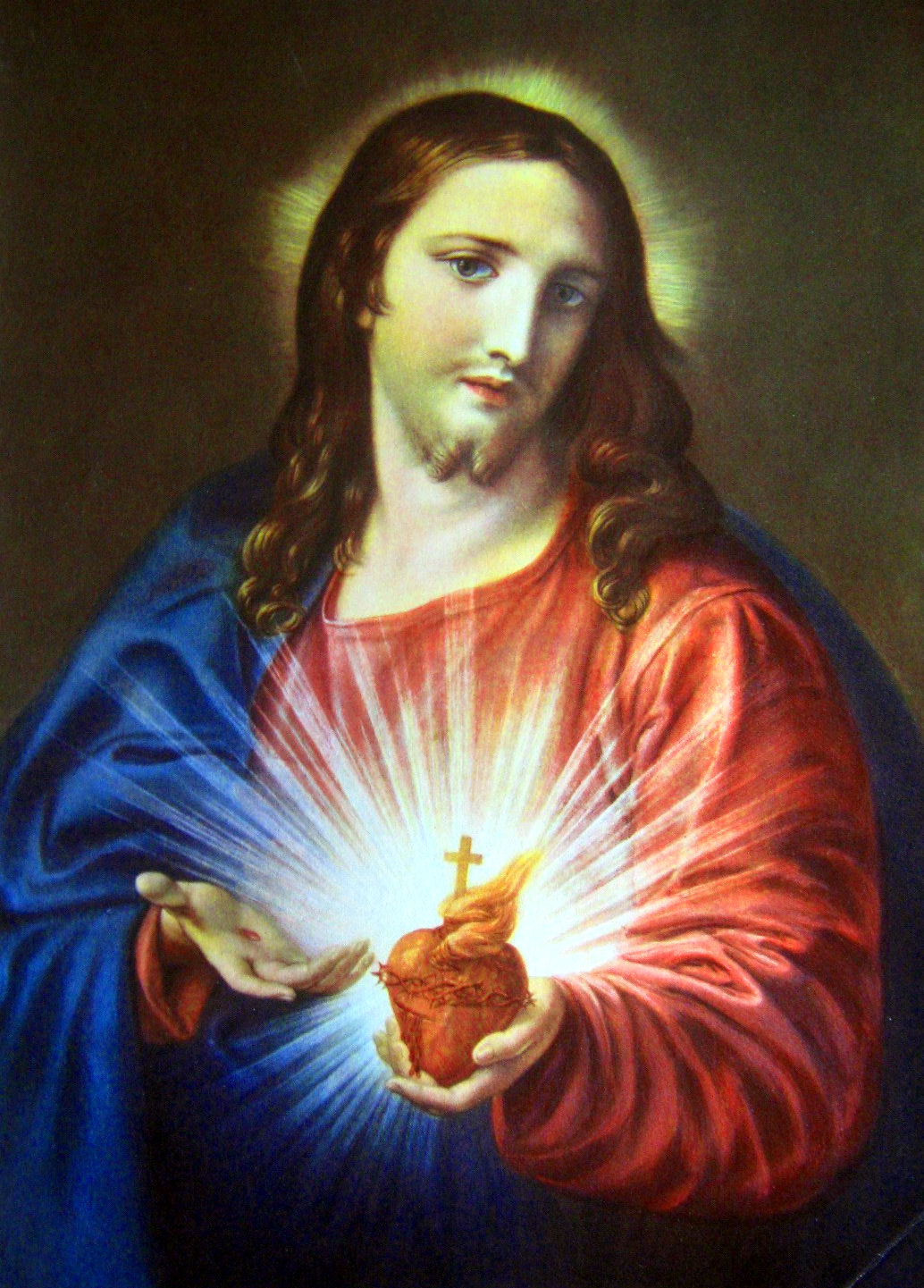
The heart is the mind where a good person like Jesus operates biologically and a bad or evil person like Satan, his mind was from his stomach as it is said in Luke 6:45;
“The good person out of the good treasure of his heart produces good, and the evil person out of his evil treasure produces evil, for out of the abundance of the heart his mouth (stoma | στόμα | nom sg neut) speaks.”
The reason these people are called evil is that they are ruled by their flesh (sarka), which has a mind of its own.
It is the mind of the material world within the heart of the earth – the domain ruled by the LORD or whom some might call the Devil.
This is why you will see the Devil and his Demons often depicted in Christain art with faces painted upon their stomachs and buttholes.
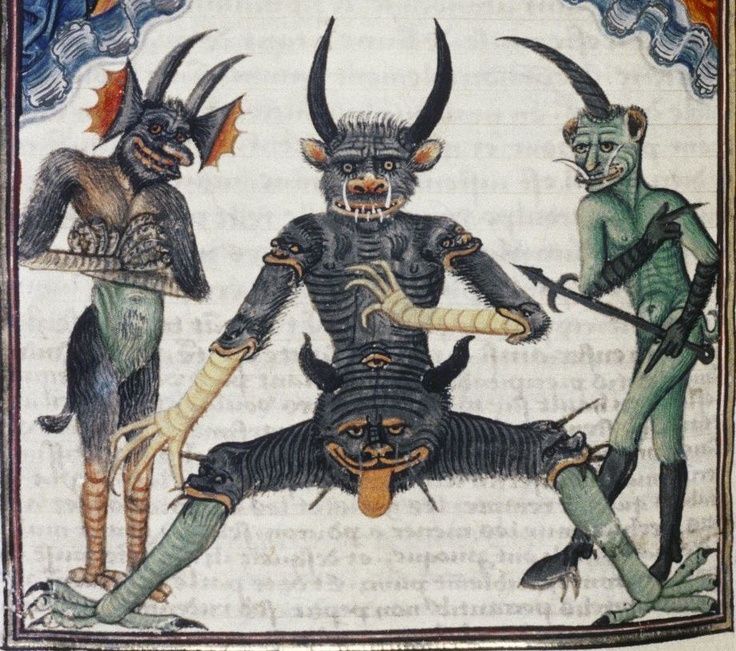
The biological domain of the so-called Devil that if we do not keep good care of often causes good people to become bad and some evil.
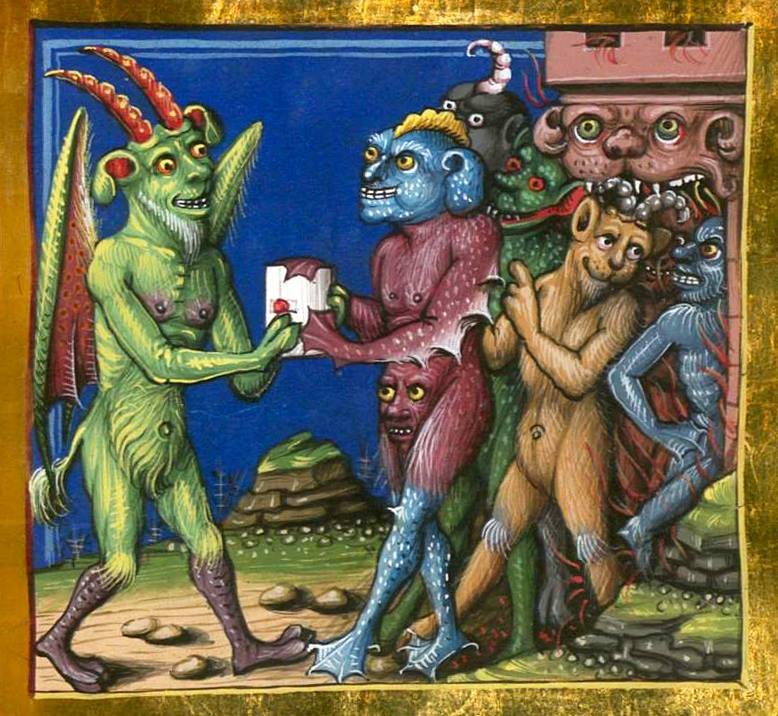
When someone operates from their stomach (stomata), their essentially talking out their ass, which has now become their face.
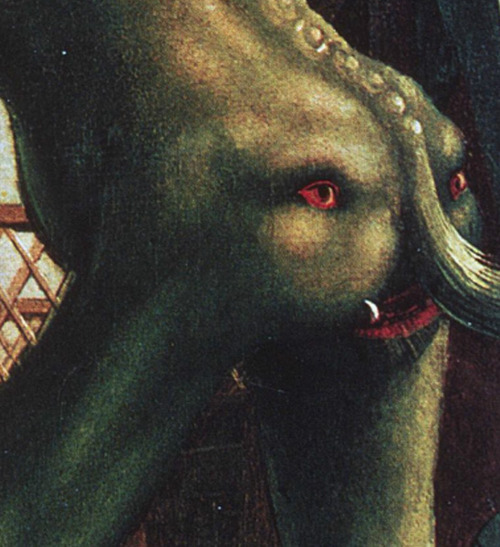
Yeah, it is like that…
To operate from the heart within the inner man was to be wholehearted and perform tasks wholeheartedly. These were the true men of “courage” and are called “men of the heart.”
The Lord is said to speak “in his heart” (Genesis 8:21); that men “know in their own heart” (Deuteronomy 8:5); that “no one considereth in his heart’ (Isaiah 44:19 the King James Version). “Heart” is this connection to the “mind,” as in Numbers 16:28 (“of mine own mind,” Vulgate (Jerome’s Latin Bible, 390-405 A.D.) ex proprio corde, Septuagint ap’ emautou). The “heart” also seems to represent “conscience,” for which there is no word in Hebrew, as in Job 27:6,
The foolish “is void of understanding,” i.e. “heart” (Proverbs 6:32, where the Septuagint renders phrenon, Vulgate (Jerome’s Latin Bible, 390-405 A.D.) cordis, Luther “der ist ein Narr”).
God is represented as “searching the heart” and “trying the reins” (Jeremiah 17:10 the King James Version).
By doing so, you were conscientious, and considerate and had the courage to act encouragingly for the fainthearted who were controlled by the heart of the earth and as a result, they were the timid and weak people controlled by their flesh.
“And then the lawless one will be revealed, whom the Lord Jesus will destroy with the breath of his mouth (stomatos | στόματος | gen sg neut), and bring to an end with the splendor of his coming.” – Thessalonians 2:8
In contrast, the heart of the earth was connected to the flesh and stomach as told in the story of Jonah being in the “belly of a whale,” like we see in Matthew 12:40:
“For as Jonah was three days and three nights in the belly of the whale, so will the Son of Man be three days and three nights in the heart of the earth.”
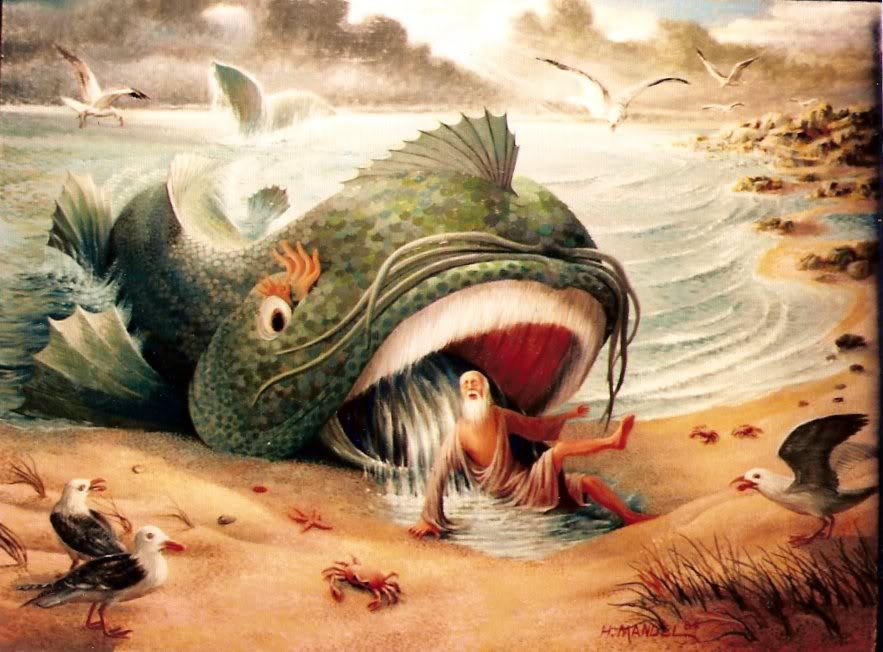
Why are people stuck in some belly and connected to the heart of the earth (biomagneticsphere)?
We read in Matthew 26:41, “Stay alert and pray lest you enter a time of trial. The spirit indeed is willing but the flesh (sarx) is weak.”
The flesh is called sarka, which the scripture informs us that it is related to the human body, 2 Cor. 7:5; flesh, human nature, human frame, Jn. 1:13, 14; 1 Pet. 4:1; 1 and 1 Cor. 5:5; 7:28; materiality, material circumstance, as opposed to the spiritual, Phil. 3:3, 4.
As Romans 8:7 says, “because the mind set on the flesh (sarkos) is hostile to God; it does not submit to the law of God; in fact, it cannot and in Romans 8:8;
“Those controlled by the flesh (sarki) cannot please God.”
These people seem to have a supernatural or medical condition that causes them to be unable to be spiritual or connect with God.
As if their minds and bodies through the flesh are governed by another entity or force that naturally precludes them being able to understand and participate in all that is good.
Scientifically, I contend that they are akin to automatons whose commands are being programed via their second brains in their stomachs i.e., gastrointestinal tracts.
These people who are unconscious to thier own realities then go on to commit various moral and legal crimes, which Paul calls the ‘works of the sarkos’.
“Now the works of the sarkos are evident: sexual immorality, impurity, sensuality, idolatry, sorcery, enmity, strife, jealousy, fits of anger, rivalries, dissensions, divisions, envy, drunkenness, orgies, and things like these. I warn you, as I warned you before, that those who do such things will not inherit the kingdom of God.” (Gal 5:19-21)
The reason that people do not obey God and they are ruled by a different force than God is because they have what the Bible calls defiled.
So “what defiles a man?”
We discover that his thoughts are what defile him.
This makes perfect sense because thoughts provide us with the guiding principles in life, which give us direction and meaning in life.
Our beliefs originate from the information we are given from others since we were children to adulthood. These sources include our parents, religion, the media, the government and other people.
Once you understand this simple concept, you then can witness how our whole culture is based on the “works of sarka” .
“Do you not yet realize that whatever enters the mouth goes into the stomach and then is eliminated? But the things that come out of the mouth come from the heart, and these things defile a man. For out of the heart come evil thoughts, murder, adultery, sexual immorality, theft, false testimony, and slander.” – (Matthew 15:18)
“But the Lord stood by me and strengthened me, so that through me the proclamation might be fulfilled, namely, all the Gentiles might hear, and I was rescued from the mouth (stomatos | στόματος | gen sg neut) of a lion.” – 2 Timothy 4:17
We know in Scripture that the symbol of the lion is directly connected to the Devil and to avoid “being eaten,” we must remain both “sober and vigilant” and we must “resist him.”
As it is said in Peter 5:8-9:
“Be sober, be vigilant; because your adversary the devil walks about like a roaring lion, seeking whom he may devour. Resist him, steadfast in the faith, knowing that the same sufferings are experienced by your brotherhood in the world.”
This Devil I contend works through the stomachs of each and every man, woman and child on earth. No one is immune from this natural law.
The key is knowing the secrets of the Devil and good and evil, which are biological processes that can be controlled by other people if you do not control them your self.
To do so, we all must remain sober.
This means we must refrain from the use of addictive substances such as sugar, alcohol or taking pharmaceutical and intoxicating drugs.
We must also remain vigilant to resist these devilish urges and when they depart, we do not let our guards down because these addictive substances and things in our culture that cause us to slip up i.e.: sin can come back into our lives at anytime for we learn in Luke 4:13:
“Now when the devil had ended every temptation, he departed from Him until an opportune time.”
It is important that we all know that these ancient teachings have been purposely kept secret by the Roman Catholic Church and government in order to control and conquer the world. Today, we are in year 2022 of this plan that is soon one day going to end.
It has to because these ancient impulses that arise in our stomachs are not only pulling the levers of billions of brains, but entire nations with the risk of the entire world being brought down to the depths of hell.
“So that what was spoken by the prophet might be fulfilled, saying, “I will open my mouth (stoma | στόμα) in parables; I will utter things kept secret from the foundation of the world.” – Mathew 13:35
And Jesus proclaimed:
“By the brightness of this light, peoples and nations will be illumined, and they will be warmed by its ardour.”
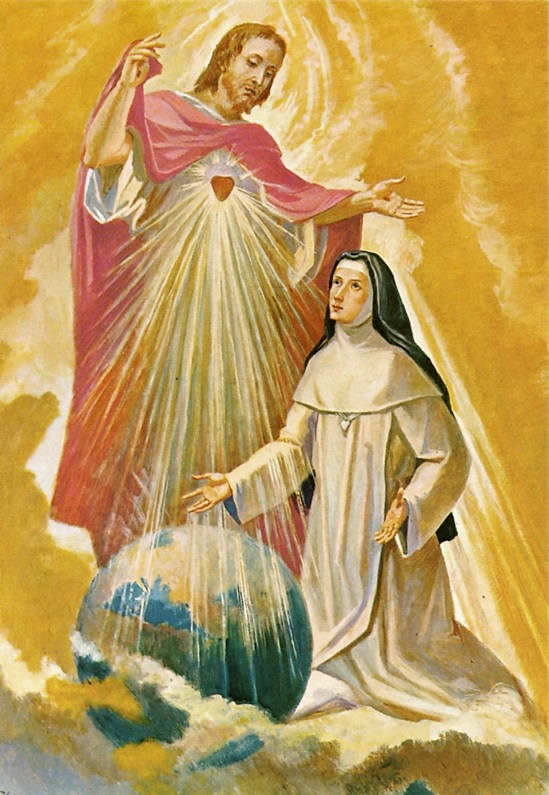
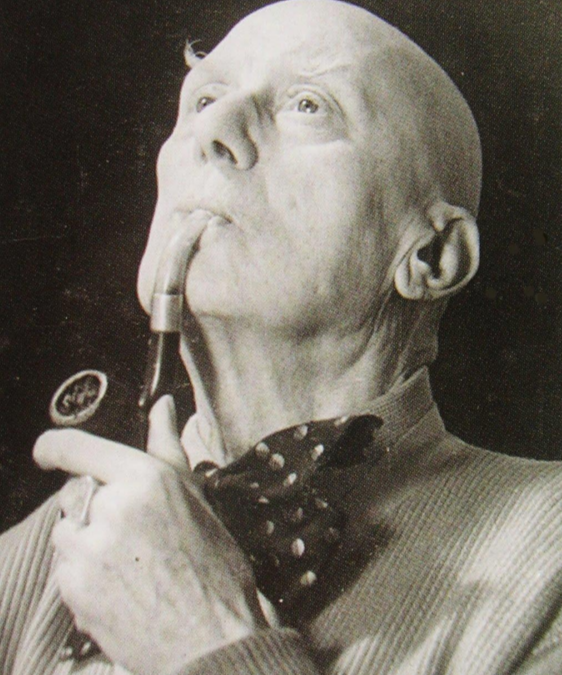
by Moe | Jul 3, 2022 | Mind Control Research, Propaganda, Satanism
The Grandfather of Modern Satanism, Aleister Crowley (1875-1947) was a British occultist, black magician, author, and secret British spy who is one of the most well-known and controversial figures of the 20th-century.
He drew quite a following from the British upper classes, who had a preoccupation with the occult and networked extensively in artistic and literary scenes where he felt perfectly at home in these circles of the elite.
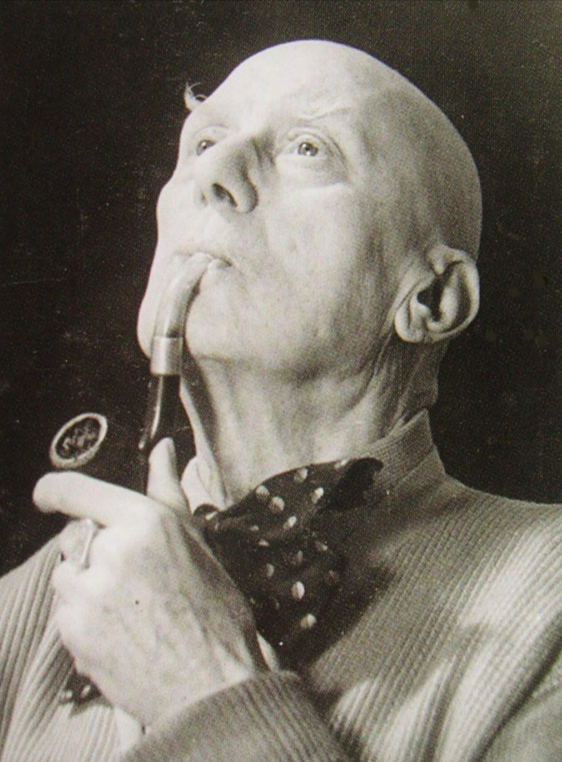
Crowley gained much notoriety during his lifetime, being a demon conjurer, recreational drug experimenter, bisexual, and an individualist social critic.
Much of the controversy surrounding him came through an association with ritual sex magick and the Enochian magick that had been practiced by the infamous consultant to Queen Elizabeth, John Dee (1527-1608).
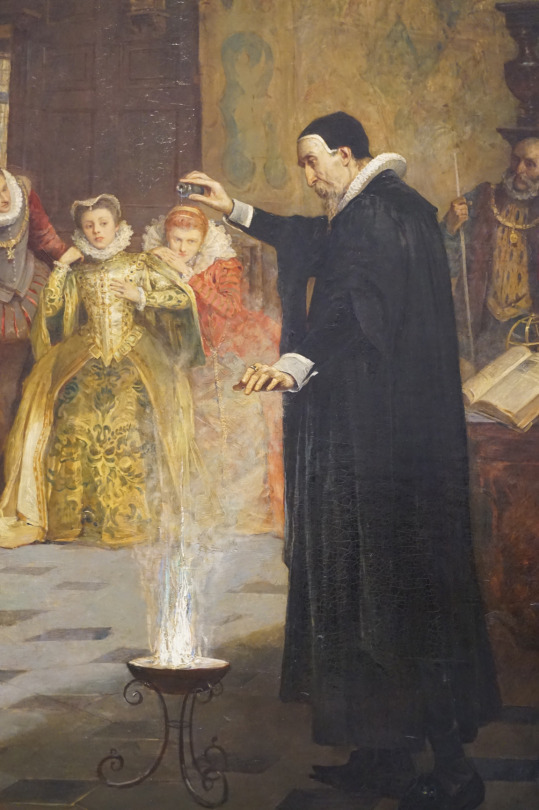
Dee used a grimoire called the Goetia (or the Lesser Key of Solomon) for conjuring angels and demons. Crowley considered himself to be the reincarnation of Dee’s assistant, necromancer and interpreter of the angelic language, Edward Kelly (1555-1597).
It was early in the 20th century when Crowley proudly proclaimed himself The Great Beast 666, who believed or acted as if he was an agent of the devil in order to help bring about humanity’s spiritual evolution.
He considered himself to be the prophet of a new age – the Æon of Horus and his religion Thelema, whose law was, “Do what thou wilt, shall be the whole of the Law.”
As he once said, “I was not content to believe in a personal devil and serve him, in the ordinary sense of the word. I wanted to get hold of him personally and become his chief of staff.” And “There are no “standards of Right”.
Ethics is balderdash. Each Star must go on its own orbit. To hell with “moral principle”; there is no such thing.” (Aleister Crowley, The Old and New Commentaries to Liber AL)
This is why the British press once labeled him “The Wickedest Man In the World,” and a 1915 Vanity Fair profile put it well, “a legend has been built up around his name. He is a myth. No other man has so many strange tales told of him.”

In addition to working for the British government, he helped spawn several Satanic organizations and influenced millions of people in the process. I argue that Crowley’s influence and propaganda helped make him the Grandfather of Modern Satanism, and I believe we can also call him the founder of Modern Atheism and Neo-Liberalism.
Crowley can be credited with influencing millions of people in the Western world with his brand of individualistic religion in the counter-culture generation from the 1960s to the 1970s up until this very day.
This is why some of his critics argue that he is also responsible for spawning a whole generation of witches, warlocks, and degenerates, in addition to being an influence on modern Satanism.
When you study his life, you will find that Crowley’s statement about being the Devil’s chief of staff may very well be true. He had worked his whole life to facilitate the removal of obstacles in Western culture, such as morality and Christian values, in order to bring about the end-time.
Whether most of Crowley’s antics and life were the product of self-will, the Devil or financed and controlled by British intelligence agencies still remains somewhat of a mystery.
One thing is for certain – his mission was to spread his brand of Satanic ethos around the world through his books and counter-culture religion of Thelema.
In fact, I believe his mission was a global success, as you will see.
Crowley’s most famous work was The Book of the Law, which he claimed to have received telepathically in June 1904 in Cairo, Egypt from a self-described supernatural entity named Aiwass. It is important to note that he identified Aiwass with Satan and with Horus’ brother Seth, which is the ancient Egyptian equivalent to the Devil in Christianity.
Thelema was primarily developed by Crowley through his written works during his lifetime. But it has continued to evolve under subsequent generations of Thelemites and Satanists who have added new interpretations and practices to it. Crowley’s Book of the Law has gone on to become a sacred text to many Left Hand Path practitioners.
It is also accepted as official writing by the Ordo Templi Orientis (O.T.O), a secret society based on sex magick of German origin.
The book predicted that humanity was ready to enter a new period of spiritual evolution, known as the “Æon of Horus” (Age of Aquarius). A new era that was supposed to be characterized by humanity embracing spiritual freedom absent from moral and social restraint.
Crowley believed that humanity could be re-initiated into a spiritualized state of existence through immoral activities and the practice of ritual sex magic and the use of drugs such as heroin, and especially cocaine, which he called “the great weapon against stupidity.”
This is why Crowley’s teachings are the complete opposite of Judeo-Christianity’s core philosophical concepts of Brotherly Love, Love Thy Neighbor as Thyself and Treat People How You Want to be Treated. Hence, the reason they are considered immoral and Satanic.
In The Book of the Law, the Satanic entity, Aiwass allegedly dictated three chapters to Crowley that are now considered to be some of the core principles that describe a philosophy he calls “Thelema.” Thelema is derived from the Greek word for “will” and is a religion of the Law of Thelema.
It is essentially an atheist, individualistic, and magical philosophy, which denies the existence of God and the Devil, and states several proclamations such as, “there is no other god but Man;” “Do what thou wilt shall be the whole of the Law”. “Love is the law, love under will,” and “Every man and every woman is a star.”
“Worship me with wines and strange drugs whereof I shall tell my prophet, and be drunk thereof! They shall not harm ye at all!” proclaimed The Book of the Law.
When one examines Crolwey’s philosophy of Thelema you will find that it is based on extreme liberalization and the individuality of a person to forge their own path in the world without any regard for morals, ethics, or the collective good of their communities. It simply means that the practitioner is encouraged to discover their True Will, whatever that may be, and to do it.
An individual should act according to his or her own will, which he defined as “love under will.” Love under will means that you love yourself and what you want to do with your life so much that you are willing to do anything to achieve your goals.
While on the surface, this philosophy does not appear to be bad or in the religious sense, evil. It is a way of life for people to do whatever you want, from promiscuous, bisexual, and homosexual sex to black magick, hardcore drugs, and lead to nihilistic self-destruction.
A type of hive mind that targets our lower and animal natures via sex and our material pleasures, making it easy to penetrate and manipulate people and the public as a whole.
What I contend creates a nationalistic “American Satanic State of Mind.”
Hell, that may have been the whole point behind his devilish mission, and if it was tied to a secret counter-intelligence operation to manipulate the public, it could be considered brilliant and Crowley, a secret agent legend among spies and occultists.
Crowley’s introduction to the London occult scene came in 1898, when he was initiated into the Hermetic Order of the Golden Dawn. Crowley had also founded the religion of Thelema, which became adopted by the Ordo Templi Orientis (O.T.O.), as well as the magical order Argenteum Astrum (Silver Star), or A∴A∴, the Order’s parent organization, and the first magical order that Crowley founded.
Several organizations were formed thereafter modeled on his teachings, of which many were founded by former members of the Golden Dawn and the Ordo Templi Orientis.
Other groups like the Church of Scientology, The Process Church of the Final Judgment, Church of Satan, and Temple of Set can all be attributed to Crowley’s lineage or an offshoot of his Satanic ideologies.
From 1909 to 1913, Crowley published the periodical called The Equinox, which was the official magazine of the Astrum Argentum (A:.A:.). Researcher, Mark Morrison claimed that, “[Crowley] needed the magazine to lend an aura of scientific, and even experimental, legitimacy to his ‘scientific illuminism,’ as he styled the mission of the A.A.”
From 1905 until the early 1940’s Crowley produced an impressive number of books on the subjects of ritual theory, magick, and yoga.
He also wrote novels (Diary of a Drug Fiend, Moonchild) and plays. In the summer of 1911, Crowley wrote his first “sex magick” treatise called Liber Stellae Rubeae (The Book of the Ruby Star) in which the star ruby represents the lingam (the Tantric phallus). This book, which was deemed holy by Crowley, “was [his] first formal ritual expression of the dynamics of sexual magic.
He wrote Magick In Theory And Practice, which was first published in Paris in 1929 under the pseudonym of “Aleister Ataturk.” Weiser Books then reissued it in 1972 with an introduction by Israel Regardie. The book is still in print today and has sold well over 3 million copies worldwide.
Many of the figures I mention below and in the next chapter were and still are extremely influential upon Western society through their books, movies, and music.
All of which had a huge impact on liberalizing the minds of millions of teenage children and young adults who sought to embrace and mimic their lifestyles of “Do Thou Wilt.”
Famous authors such as Jack Kerouac and William S. Burroughs, both of whom were Beat Generation writers who wrote about their experiences with drugs and the occult.
Also Ian Fleming (who used elements of Crowley’s life in his James Bond novels), J.G. Ballard (who based some characters on Crowley in Crash), and John Fowles (who used Crowley as inspiration for the character Professor Slocombe in The Magus).
Jack Parsons, who was a rocket scientist at the Jet Propulsion Laboratory (JPL) and CalTech. Parsons was also an influential member of the Ordo Templi Orientis, often referred to as the O.T.O., an occult organization that Crowley founded in 1907.
He would later become a successful rocket scientist after his exposure to the teachings of Crowley, who saw him as the “magus” or high priest of his new religion.
Parsons would use his skills to help NASA develop rockets for space exploration and research, including working on the V-2 rockets during World War II that were designed by Wernher von Braun (who later helped develop America’s first satellite).
Another figure influenced by Crowley was former Naval intelligence officer who became the founder of the Church of Scientology, L. Ron Hubbard.
He became one of America’s most famous writers after writing The Book of Dzyan in New York City in 1934 while studying with Crowley himself.
Crowley would also be idolized by Timothy Leary, a famous psychologist who experimented with LSD in the 1960s and 1970s. He wrote about his experiences in The PsychTimothyedelic Experience: A Manual Based on The Tibetan Book of the Dead.
Leary said that he had been inspired by Crowley’s book Liber AL vel Legis (The Book of the Law), which he called “the most enlightened statement ever written”.
In addition, Crowley had a huge impact on many other famous Satanists and occultists like Kenneth Anger, Kenneth Grant, Gerald Gardner (founder of Wicca), Robert Anton Wilson (author of Illuminatus), and Damien Echols (Convicted Child Murderer – West Memphis Three).
Kenneth Grant wrote several books about him and his ideas (including The Magical Revival) and he was friends with Dennis Wheatley, whose books include several novels based on Crowley’s ideas (Wheatley even wrote a biography of Crowley).
When I examine the chain of events that led to the formation of Satanic State of America, I see the true aristocratic bloodline of Modern Satanism. The evidence proves that Crowley’s Satanic influence upon American, British, and Western culture, in general, has been incredibly profound.
Today, we can see how his philosophy is deeply rooted within American culture with the help of many artists in the music industry, authors, filmmakers, and the tens of millions of people who were influenced by these same people.
The Grandfather of Modern Satanism, Aleister Crowley, The Golden Dawn, and the O.T.O. were the Satanic seeds in America and the West that were the origin of this underground movement. The famous people, celebrities, and bands who emulated these teachings would be the resulting infection spreadingnSatanism around the globe.
Crowley and his fellow Satanists would be the viral contagion that, with clever marketing, media, and the secret help of intelligence agencies, hijacked the music movement acting as its superspreaders.
Up out of hell would sprout like mushrooms the likes of Anton LaVey with the Church of Satan Inc., The Process Church of the Final Judgment, and the U.S. Army Col., Michael Aquino and his brand of Scientific Satanism called the Temple of Set. Aquino’s brand of scientific-based occultism and black magic would be the perfect fit for modern warfare as head of Army Psyops instituting the Mind Wars.
All of whom would incorporate it all into their own brands of official Satanic doctrine—indoctrinating a whole generation of wayward youth, spawning some of the best rock, heavy metal, punk bands, and spies the world has ever witnessed.
Like they were spawned from the abyss, Satanists on the fringe side of the movement would birth serial killers like David Berkowitz (The Son of Sam), Richard Ramirez, and one of the most celebrated, Charles Manson, whose Satanic adventures I will also share with you coming up.
I do not contend that all these different people that I have mentioned or will mention in the next chapters were all magically managed by Crowley. Nor were they an organized group or had any type of central planning. They were all Satanists who individually forged their own paths.
What I do propose was that much of the movement was the end result of Crowley’s ideas, magic, and his brand of Satanic ethos being “Do thou wilt.” An individualistic, neoliberal, immoral and sometimes criminal way of life that all have a common source of origin.
That source was Crowley.
And all the while, he was a secret spy working as an asset for British intelligence, as I will also detail in a following chapter.
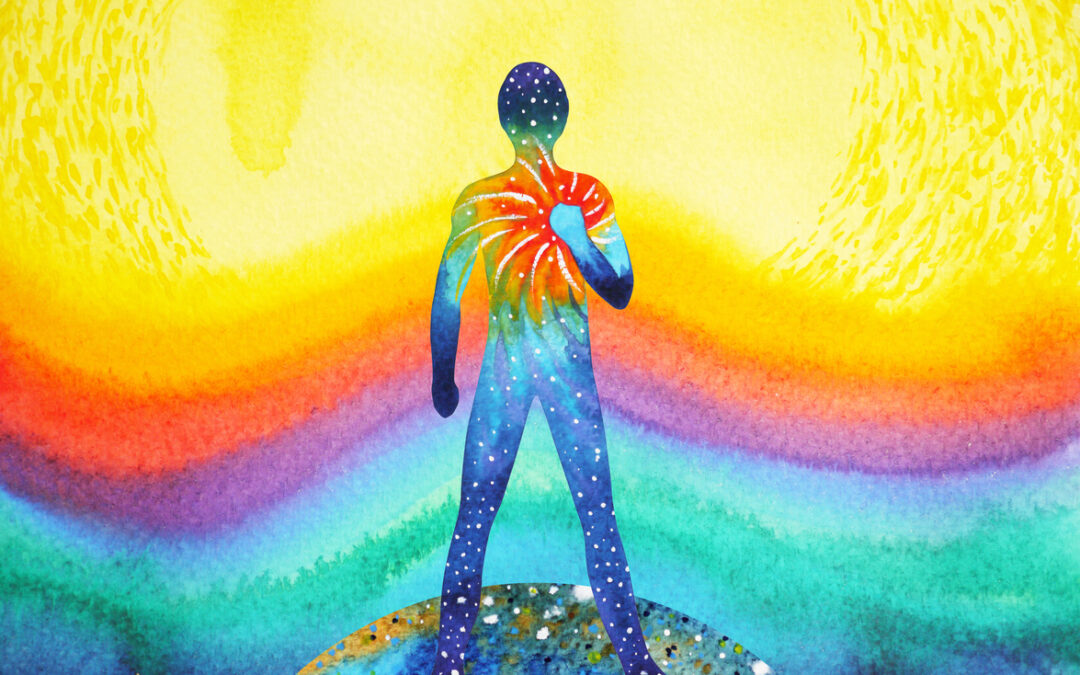
by Moe | Apr 5, 2022 | Duality, Philosophy, Quotes
It is important that you understand that Pythagoras held our souls come from the number One (1) which is derived from the first principles and assigns God and the soul to the number One.
This is our soul’s connection to the One Monad, which is God and the good, which is the origin of the One, and is itself intelligence, reason, and its end result, immortality (ie: True Gnosis – One With Christ in the Head).
These they call Divine spirits [δαιμονες] who are psychical beings (i.e. real people with purified souls).
However, Pythagoras taught that when the One becomes two, it becomes the “undefined dyad (ie: Duality or something consists of two elements or parts)” which is a divinity and the bad, surrounding which is the mass of matter.
We can say that this is a man divided against himself, imbalanced, and is ignorant (i.e. No Gnosis) of these Sacred Laws.
Pythagoras regarded the “soul of man between spirits” who always contemplated the Divine Essence (i.e.: their soul, true selves).
We are born into the world in a fallen state (ie: ruled by the passions and desires of the material world) which makes us forget our spiritual natures and divine selves.
Pythagoras had taught that it was from our separation from the Deity that we lost the wings which raised us towards celestial beings, and were thus precipitated into the region of death where all evils dwell.
By putting away earthly passions and devoting ourselves to virtue, our wings will be renewed, and we shall rise to that existence where we shall find the true good without any admixture of evil.
Through the process of life, death and rebirth our wings will be renewed, and we shall rise to that existence where we shall find the true good without any admixture of evil.
In Christian Scripture, this is what is called the “fall of man,” which is a term used in Christianity to describe the transition of the first man and woman from a state of innocent obedience to God to a state of guilty disobedience (ie: a life of sin).
It was said that when a man is in this state, he moves in its aerial clothing, and is thus subject to Fate ie; evil and temptation, because his whole life is attached to its earthly interests and material pursuits (money, fame, pleasure etc.).
Therefore, man is not pure, and it is only when he casts off this earthly garb of the first spheres and becomes ethereal, i.e.: Spiritual, that he becomes sure of his immortality.
The entire doctrine of the Pythagoreans would culminate in assisting initiates to connect with the One – The Monad AKA Their Soul, and through knowledge AKA Gnosis, to become masters of the self, the world and the spirits who inhabit “both.”
The Russian occultist, philosopher, and author Madame Helena Petrovna Blavatsky (HP Blavatsky) had said about Pythagoras, “Pythagoras, the pure philosopher deeply versed in the profounder phenomena of nature, the noble inheritor of the ancient lore, whose great aim was to free the soul from the fetters of sense and force it to realize its powers, must live eternally in human memory.”
In other words, by learning how to die, we accomplish the most fantastic goal of all humans which is saving our own souls – The One via “The Great Work.”


















